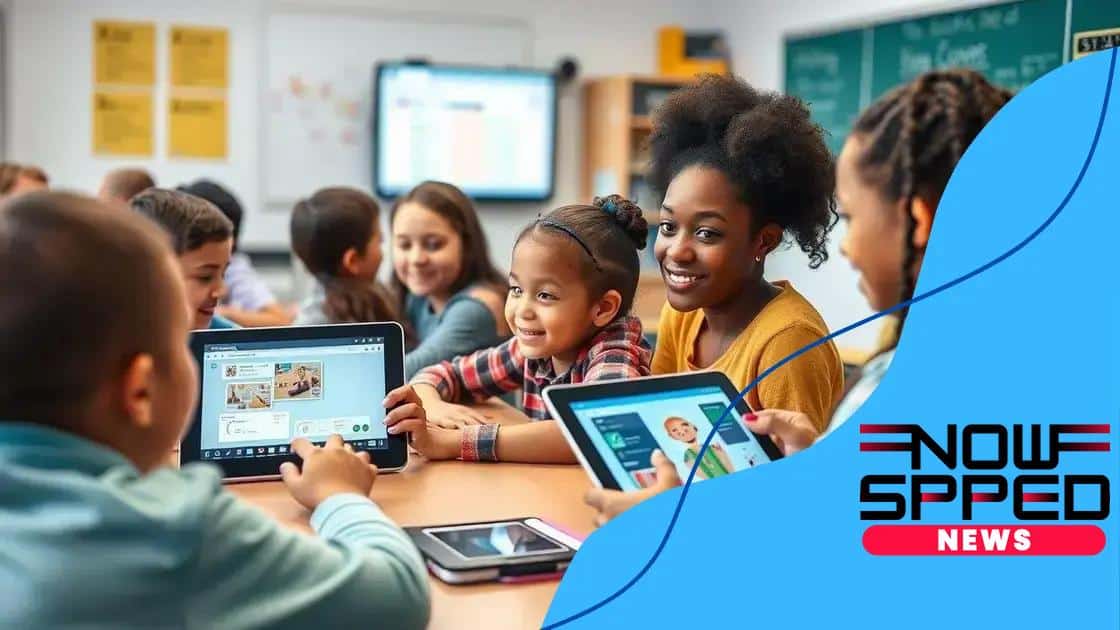AI tools for engaging students in the classroom

AI tools significantly enhance student engagement in classrooms by providing personalized learning experiences, facilitating interactive activities, and adapting to individual needs, making education more effective and accessible.
AI tools for engaging students in the classroom are rapidly changing how educators connect with learners. Imagine a classroom where students are not just passive recipients of information, but are actively participating and collaborating. Interested in how these tools can foster a dynamic learning environment?
Exploring the concept of AI in education
Understanding the concept of AI in education is essential for modern teaching methods. Schools worldwide are integrating artificial intelligence to enhance learning experiences and improve student engagement.
AI can analyze vast amounts of data to tailor education strategies for each student. This personal approach means that students receive support based on their unique needs and learning styles.
What does AI bring to the classroom?
Incorporating AI tools helps educators by offering:
- Personalized learning experiences
- Automated grading and feedback
- Data-driven insights for better teaching decisions
- Engagement through interactive tools
The shift towards AI means that students can learn at their own pace. Imagine a classroom where struggling students receive extra help instantly while advanced learners are challenged with more complex problems.
How AI supports diverse learning styles
Another remarkable aspect of AI is its ability to adapt to various learning preferences. Some students benefit from visual aids, while others thrive through auditory methods. With AI tools, teachers can deliver content in different formats, catering to the diverse needs of their class.
Furthermore, AI-driven platforms can monitor student engagement and performance. When teachers are equipped with this critical information, they can adjust their teaching methods accordingly. This adaptability is vital in keeping all students on track and motivated.
As we continue to explore the concept of AI in education, it’s evident that these tools are not just a trend. They represent a substantial shift toward enhancing the educational landscape for both students and teachers.
How AI tools enhance student engagement
AI tools play a crucial role in enhancing student engagement in the classroom. With the integration of these technologies, students can participate in a more interactive and personalized learning experience.
By utilizing AI, teachers can create engaging lessons that resonate with students. Moreover, the adaptive nature of AI allows it to cater to individual learning styles.
Ways AI tools increase engagement
Here are some notable ways AI enhances student engagement:
- Real-time feedback helps students understand their learning progress.
- Gamification of lessons keeps students motivated and eager to learn.
- Interactive simulations and virtual environments make learning fun.
- Customized learning paths ensure that each student gets the right challenges.
Consider using AI-powered applications in your classroom. These tools can provide unique insights into student performance and preferences. For instance, an AI system can analyze how students respond to different types of content and adjust accordingly.
The impact of AI on student participation
Another vital aspect is how AI can encourage participation among students who may feel less confident. AI tools can create a safe space for them to engage without the fear of judgment. When students feel comfortable, they are more likely to participate actively in discussions.
Additionally, AI-driven analytics can highlight students who might need extra support, allowing teachers to intervene promptly. This timely assistance can keep all students engaged and on track.
As the educational landscape evolves, the importance of AI tools in fostering student engagement cannot be overstated. These technologies offer opportunities for teachers to connect with students in meaningful ways.
Real-life examples of AI in classrooms

Real-life examples of AI in classrooms showcase how technology can transform education. Many schools and educators are successfully using AI tools to improve the learning experience.
One notable instance involves the use of AI-based tutoring systems. These systems offer personalized support to students, helping them grasp difficult concepts at their own pace.
Effective applications of AI in education
Here are some effective applications of AI you might find in classrooms:
- Intelligent tutoring systems that guide students through complex subjects.
- AI-enhanced learning platforms that adapt to individual student needs.
- Chatbots providing 24/7 assistance with homework and study materials.
- Data analysis tools to track student performance and predict outcomes.
In addition to tutoring, AI is being used for classroom management. Teachers utilize AI tools to track attendance and manage grades more efficiently. These tools save valuable time, allowing teachers to focus on instruction and student interaction.
Case studies of successful AI integration
Multiple case studies demonstrate the successful integration of AI in education. For example, some schools have implemented AI to enhance language learning. Students use applications that tailor vocabulary and grammar exercises based on their progress.
Another case involves schools utilizing AI to create individualized learning plans. By analyzing students’ strengths and weaknesses, the AI can suggest customized materials that foster growth. This targeted approach leads to higher engagement and improved academic performance.
As these real-life examples of AI in classrooms reveal, the potential for innovation in education is vast. By leveraging technology, educators can create a more effective and engaging learning environment.
Tips for implementing AI tools effectively
Implementing AI tools effectively in the classroom can enhance learning experiences. By following some strategic tips, educators can maximize the benefits of these technologies.
First, it’s essential to assess the needs of your students. Understanding their learning styles and challenges will help you choose the right AI tools that fit your goals.
Key strategies for effective implementation
Here are some key strategies to consider:
- Start with small pilot programs to test the effectiveness of the chosen AI tools.
- Provide training for teachers to ensure they are comfortable using the technology.
- Collect feedback from students to understand their experiences with the tools.
- Ensure technical support is available to address any issues quickly.
After selecting the right tools, integrating them smoothly into the curriculum is crucial. Determine how these tools can complement existing lessons. For example, using AI for personalized homework assignments can be a great addition to traditional methods.
Creating a supportive environment
Another important factor is creating a supportive learning environment where students feel empowered to use AI tools. Encourage students to explore the technology and make suggestions for improving their learning experiences.
Monitoring the impact of AI tools on student performance is vital. Analyze data regularly to see how they influence engagement and learning outcomes. Adjust your approach based on what the results show. By emphasizing a data-driven approach, educators can continually improve how they use AI in education.
Through careful implementation, educators can ensure that AI tools become an effective part of their teaching toolkit, leading to more engaging and personalized learning experiences for all students.
Future trends of AI in educational settings
The future trends of AI in educational settings promise significant transformations in how we teach and learn. As technology evolves, educational institutions are expected to adopt innovative tools that enhance the educational experience for both students and teachers.
One major trend is the rise of adaptive learning platforms. These platforms use AI to analyze student performance in real-time, adjusting the curriculum to fit individual needs. This tailored approach allows students to learn at their own pace, making education more effective.
Emerging technologies and their impact
Several emerging technologies will shape AI’s role in education:
- Virtual reality (VR) and augmented reality (AR) will offer immersive learning experiences, bringing subjects to life.
- AI-driven analytics will provide educators with insights into student learning patterns, improving teaching strategies.
- Natural language processing tools will assist in language learning and improve communication between students and teachers.
- Collaborative AI tools will enhance group projects, enabling real-time feedback and support.
As we look forward, AI is also expected to improve accessibility in education. Tools designed for students with disabilities will become more advanced, ensuring that everyone has equal learning opportunities.
Personalized education experiences
Another trend is the focus on personalized education experiences. AI will help create rich, individualized learning pathways that adapt to each student’s interests and strengths. With the ability to gather data efficiently, AI can suggest resources and activities that resonate with each student.
The integration of AI into educational settings will also encourage lifelong learning. Skills and information are changing rapidly, and AI-enabled platforms can help individuals continue their education beyond traditional classroom settings.
In conclusion, the future of AI in educational settings holds great potential. With innovative technologies and a focus on personalization, learning could become more engaging, accessible, and tailored to each student’s unique journey.
FAQ – Frequently Asked Questions about AI in Education
How can AI tools personalize learning experiences for students?
AI tools analyze individual student performance and learning styles, allowing for customized pathways that meet their unique educational needs.
What are some examples of AI technologies used in classrooms?
Examples include intelligent tutoring systems, AI-driven analytics platforms, and virtual reality tools that enhance engagement and learning.
How does AI improve accessibility in education?
AI solutions are designed to assist students with disabilities, ensuring they have equal access to educational resources and opportunities for growth.
What should teachers consider when implementing AI tools?
Teachers should assess student needs, provide adequate training, start with pilot programs, and gather feedback to ensure the tools are effective.





